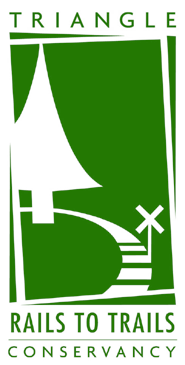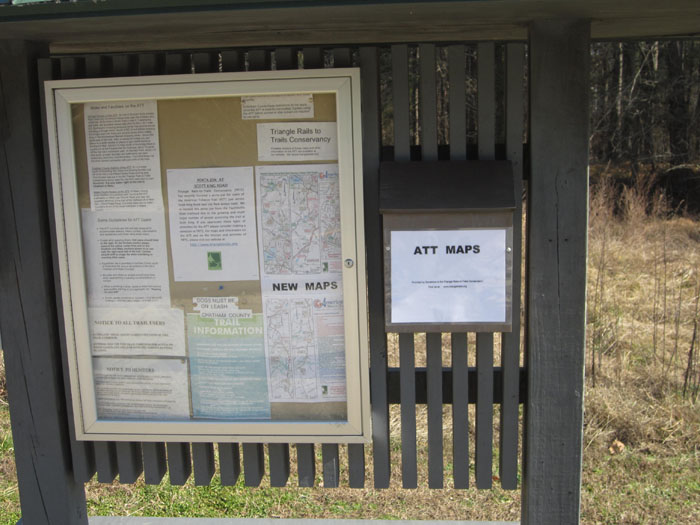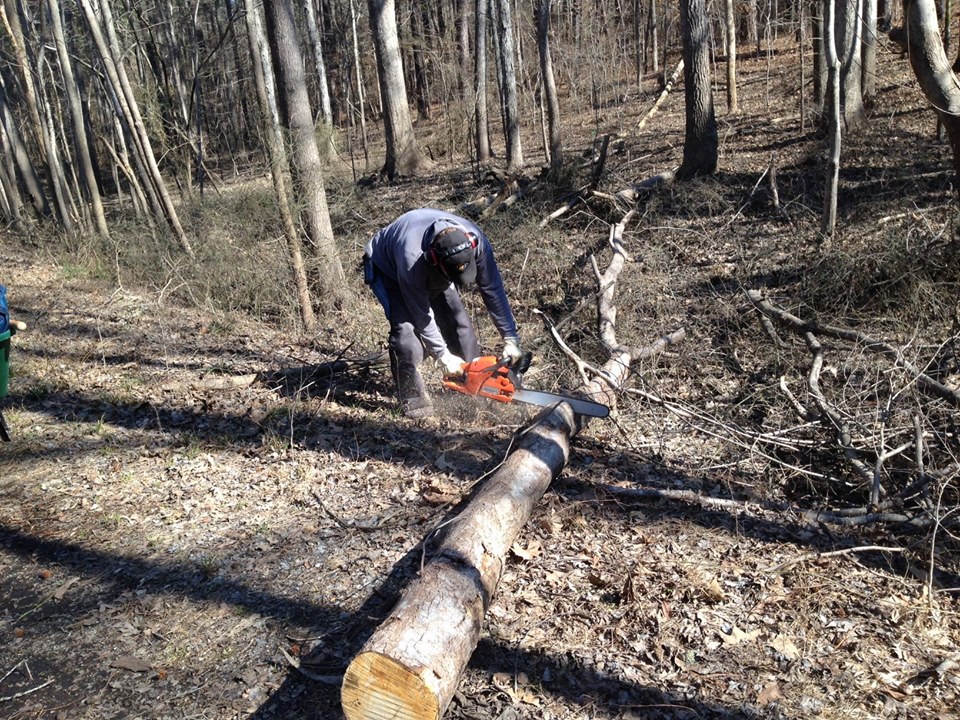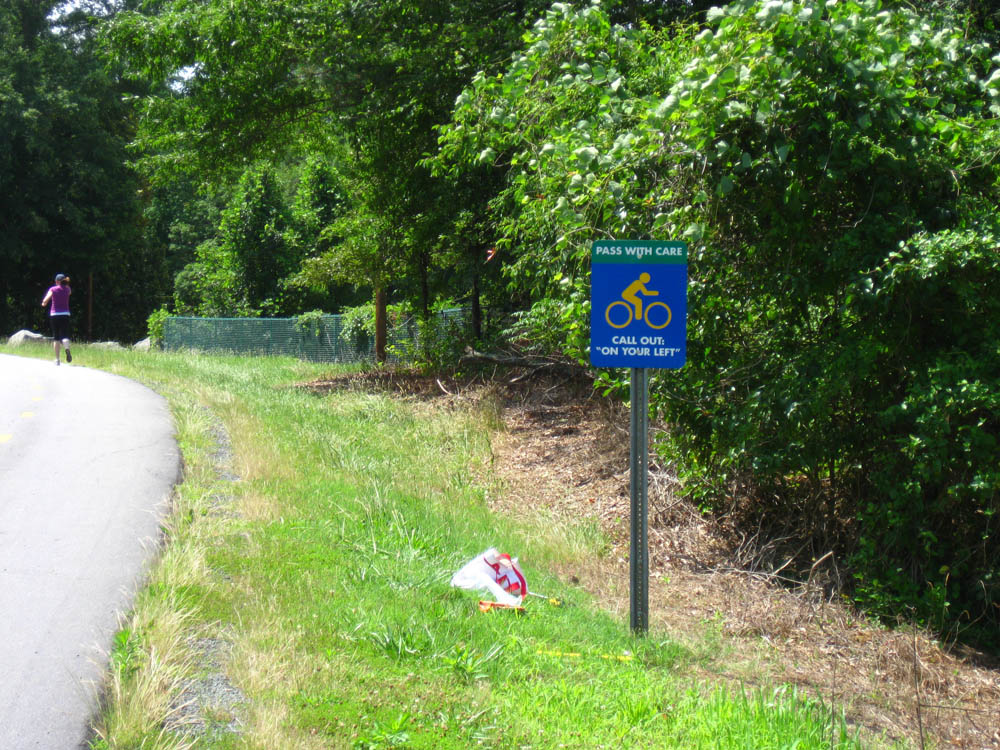1. When did they start building the American Tobacco Trail?
- The half-mile section behind the Kroger/Southpoint Crossing shopping center up to Dunhill Drive in Durham was actually the first to be built, and that was in 1998. TRTC has been involved in ATT advocacy since the Master Plan for the ATT was completed in 1992.
- The first major ATT section was opened in June 2000 between Morehead Avenue and Cornwallis Road in Durham. Wake County completed its first section in 2003.
2. Why is it called the American Tobacco Trail?
- The trail mostly uses the old railroad corridor that stretched from Bonsal to downtown Durham. The rail line serviced the American Tobacco Company’s factory in Durham, and was the source of the name.
3. How long is the ATT now that it’s all connected?
- The trail stretches from Morehead Avenue in Durham all the way to the trailhead near New Hill-Olive Chapel Road in Wake County, a little over 22 miles. This does not include the Riddle Road Spur or Eagle Spur trail off of Stagecoach Road.
- Note that the trail system north of Morehead Avenue in Durham is not the ATT; that is the city’s North/South Greenway system.
4. What is the Triangle Rails to Trails Conservancy (TRTC)?
- They are the non-profit incorporation that advocated for the purchase of the old rail corridor, and its conversion to a trail, since the late 80s.
- Once the corridor was purchased, the group has monitored the development of the trail and lobbied to keep the project moving forward.
- TRTC coordinated thousands of volunteer hours and a DOST grant to begin cleaning, clearing and maintaining the old rail corridor in southern Durham County, opening it for trail use years before the city could do so. Through a grant from the State, TRTC cleared and constructed a trailhead parking area adjacent to the trail on Fayetteville Road. This was transferred to the City of Durham in July 2009.
- From 2003 until mid-2008 TRTC coordinated a significant effort to open the trail up in Chatham County.
- In 2012 we funded a trailhead and dirt parking area at the trail crossing at Pittard Sears road in Chatham County. In 2013 we were able to install a drinking fountain there which was the only water available south of Herndon Park for several years. With grant funds from the Tobacco Road Marathon and other donors we were able to build a new gently sloped, hard surface access trail at Pittard Sears in 2018 including a handicapped parking space.
5. What should I do if I encounter horses on the trail from either direction?
- BICYCLISTS: Always approach and pass horses SLOWLY, and be prepared to stop if the horse seems nervous. Ask the horse rider if the horse is ready for you to pass. Bicycles are very quiet and can startle a horse if an audible warning and slower speed is not used. Also, for your safety, do not pass the horse closely; pass on the opposite side of the trail.
- PEDESTRIANS: Approach and pass from either direction on the opposite side of the trail from the horse to allow ample room. It is not safe to travel close to a horse in case it shies at something on the trail. With just a little patience and courtesy on everyone’s part, all the different user groups can have a safe and enjoyable visit to the American Tobacco Trail.
6. What and where is the Eagle Spur trail?
- The Eagle Spur trail is ~2.5 miles in length and can be accessed from Stagecoach Rd. in southern Durham County. The Eagle Spur has a natural surface, is quite rural in nature and provides a connection to Jordan Lake. Please see our new map of the Eagle Spur trail. This short spur trail is part of the original railroad route from Durham to Duncan. This section of the corridor was removed from service in the early 1970s due to the future filling of Jordan Lake several years later.
- This section of the B. Everett Jordan Lake Project, which is currently managed by the North Carolina Wildlife Resources Commission, is reportedly the largest summertime roost of bald eagles in the Eastern United States. Over the years, TRTC has performed maintenance of the Eagle Spur as needed to remove fallen trees and make minor surface improvements. Since 2011 TRTC has undertaken more substantial improvements to the trail and to several drainage culverts. This has been a challenging project; we acquired 3 large (36″ diameter) double walled drainage culverts in 2016 and have installed 2 as of late 2023. With adequate volunteer efforts we hope to complete putting in the third culvert during 2024.
7. Why aren’t horseback riders required to clean their horses’ waste from the trail, as dog walkers are asked to do?
- There are a number of reasons why this is not required: Safety issues are the primary reason why equestrians are not expected to dismount immediately and clean their horses’ manure from the trail. Dismounting, holding a horse by the reins, trying to scrape the waste from the trail while controlling a horse from the ground, then trying to remount the horse all offer potential problems for the rider and/or other trail users.
- Many horseback riders would have a difficult time remounting their horses while on the trail. They use mounting blocks when they mount, which would not be available to them on the trail.
- If a horseback rider were to stop, dismount, and clean manure from the trail, all other trail users would need to stop on the trail and wait until the rider had finished the clean-up and remounted the horse. It would not be safe for another trail user to pass the horse while the rider is cleaning the trail and remounting. Other trail users would undoubtedly find this delay to be frustrating.
- Horseback riders are not always aware that their horses have left some manure on the trail. Horses do not need to stop and stand when defecating. They can keep moving, and the rider will not be aware that the horse has left some droppings to be cleaned up.
For these reasons, it was decided that horseback riders on the ATT would not be expected to stop immediately to clean their horses’ waste from the trail. Instead, a volunteer group (many, but not all, of whom are horseback riders who use the trail) was formed to manage clean-up of horse waste on the trail.
8. If volunteers clean the trail, why do I sometimes see manure on the trail?
- Volunteers are scheduled to clean horse waste from the trail on a weekly basis from the New Hill end to New Hope Church Road (where pavement starts). Occasionally, the weather or other circumstances may prevent cleaning on a scheduled day, which may delay trail cleaning until the following week. It is important for other trail users to understand that they may encounter some horse waste on the trail in between cleanings. The intent of cleaning horse waste from the trail is to keep horse waste from accumulating too much on the trail, rather than to keep the trail completely clear of manure at all times. The ATT does not have heavy horse use, so there is not a great deal of horse waste on the trail, and what little is there in between cleanings can be easily avoided, just as a user would bypass a branch or puddle on the trail.




